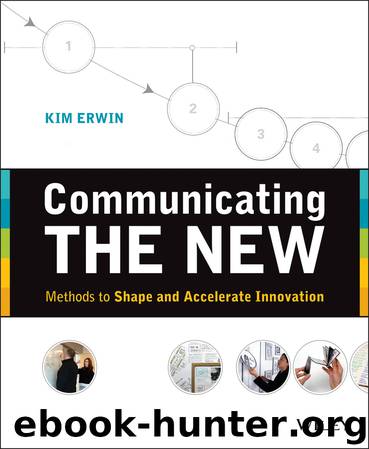Communicating the New by Kim Erwin

Author:Kim Erwin
Language: eng
Format: epub
Publisher: Wiley
Published: 2013-07-08T16:00:00+00:00
Taking on organizational orthodoxies
If mental models create interpersonal minefields, orthodoxies create disabling blind spots about what’s possible and what’s desirable for an entire organization. They can lead to rigid thinking and myopic vision—barriers to The New that are difficult to dislodge from the outside. Ben Jacobson states well the danger of orthodoxies: “When I hear people say we will never be in the business of X, Y, Z, that’s always a warning flag for me because I think things migrate so much. Everybody likes to use Apple as an example, but back when they were making computers and the first personal desktop computers, they never knew that all of their money was going to come from phones and music. The path that got them there? Well, they didn’t say ‘we’re never going to be in the music business.’ They would have missed the boat, right?”
Larry Keeley has long made exposing orthodoxies a core part of his firm’s practice: “Organizational orthodoxy is extremely important. Doblin uses robust methodologies to tease out orthodoxies, and what’s great is [that] if you get the client themselves to identify, externalize and even laugh at their own orthodoxies, it accomplishes two things. It gives clients the habit of understanding that they will tend to look at literally everything unfamiliar through a filter of what is familiar and tend to reject the things that are unfamiliar. Separately, it gives them the sense that this is actually a discipline—that to innovate they’re supposed to consciously flip around.”
Rejection of the unfamiliar is one of the great ironies of initiatives designed to create The New. Every leader of The New has encountered the invisible threshold that separates “blue sky” from outer space, by inadvertently stepping across it. One client of mine, having enthusiastically signed up for a ground-up rethink of their product category, clued us in early with this hallway comment: “This company needs change . . . [pausing] well, as long as it’s not too different.” It was a telling moment—more candid and self-aware than most. The client’s limited appetite for risk and disruption was revealed, and we began to think from day one how to stretch them past it.
Download
This site does not store any files on its server. We only index and link to content provided by other sites. Please contact the content providers to delete copyright contents if any and email us, we'll remove relevant links or contents immediately.
| Bookkeeping | Business Mathematics |
| Business Writing | Communications |
| Decision Making | Negotiating |
| Project Management | Running Meetings & Presentations |
| Secretarial Aids & Training | Time Management |
| Training |
Nudge - Improving Decisions about Health, Wealth, and Happiness by Thaler Sunstein(6679)
Deep Work by Cal Newport(5566)
Principles: Life and Work by Ray Dalio(5368)
The Doodle Revolution by Sunni Brown(4077)
Factfulness: Ten Reasons We're Wrong About the World – and Why Things Are Better Than You Think by Hans Rosling(4052)
Thinking in Bets by Annie Duke(3562)
Eat That Frog! by Brian Tracy(3559)
Writing Your Dissertation in Fifteen Minutes a Day by Joan Bolker(3316)
Hyperfocus by Chris Bailey(3312)
Visual Intelligence by Amy E. Herman(3301)
How to Win Friends and Influence People in the Digital Age by Dale Carnegie & Associates(2859)
How to win friends and influence people by Dale Carnegie(2855)
Schaum's Quick Guide to Writing Great Short Stories by Margaret Lucke(2827)
Hidden Persuasion: 33 psychological influence techniques in advertising by Marc Andrews & Matthijs van Leeuwen & Rick van Baaren(2812)
The Pixar Touch by David A. Price(2762)
Ogilvy on Advertising by David Ogilvy(2723)
The Slow Fix: Solve Problems, Work Smarter, and Live Better In a World Addicted to Speed by Carl Honore(2592)
Work Clean by Dan Charnas(2579)
The Content Trap by Bharat Anand(2511)
